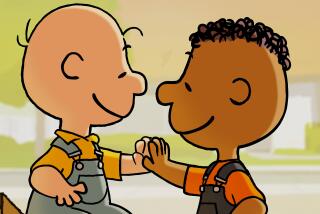John Culhane dies at 81; Disney animation historian inspired Mr. Snoops character
- Share via
When 17-year-old John Culhane and three friends motored west from Rockford, Ill., in 1951, it was for much the same reason as legions before them: Someone had a friend who had a friend who knew someone big — someone really big — in Hollywood.
In this case, the friend of a friend was Diane Disney, daughter of Culhane’s idol, Walt Disney.
To Culhane’s amazement, the connection worked. For six hours on an August Sunday, young Culhane rambled the grounds of the Disney estate with Walt himself, who advised the fledgling writer to “work for your hometown newspaper, write for your neighbors — and just keep widening your circle.”
Culhane did just that, reporting for the Rockford Register-Republic, the Chicago Daily News, Newsweek and Reader’s Digest before writing acclaimed histories of animation, Disney cartoons, special effects, and the circus.
Culhane, who took detailed notes on the back of a church bulletin about his meeting with Disney, died July 30 at his home in Dobbs Ferry, N.Y. He was 81.
His death was caused by complications of cardiac failure and Alzheimer’s disease, according to an announcement from the Walt Disney Studios.
Culhane never wrote the Disney biography that he told Walt he wanted to write. But he was so well known around the studios that animators twice created characters by caricaturing him: Flying John, in “Fantasia/2000” and, more famously, Mr. Snoops, a weaselly underling of the evil Medusa in “The Rescuers” (1977).
“True, he’s the villain but it’s a kind of immortality,” Culhane told Contemporary Authors. “I’m not only on a lunch pail — I’m even on the thermos! Delighted!”
In fact, delight was an organizing principle of Culhane’s life, despite the gritty scenes he encountered as a journalist.
As a newspaper reporter, Culhane went undercover to expose a Chicago slumlord. At the 1968 Democratic convention, he was beaten by police. Reporting on a race riot in Milwaukee, he took cover from gunfire under a car. In the Middle East for Newsweek, he was blindfolded by Palestine Liberation Organization partisans and driven into the hills of Jordan for an interview with Yasser Arafat.
NEWSLETTER: Get the day’s top headlines from Times Editor Davan Maharaj >>
On the same trip, he delighted children at a refugee camp with his ever-present Mickey Mouse watch.
“He started singing, ‘Heigh-ho, heigh-ho,’ and he had all these kids marching behind him,” his wife, Hind Rassam Culhane, told The Times. “All he had to do was show his watch and kids would sing. He carried that magic with him.”
Born Feb. 7, 1934 in Rockford, Ill., Culhane was the son of a funeral director and a teacher.
He attended St. Louis University, picked up a job on his local paper and eventually free-lanced for publications including the New York Times magazine, Saturday Review and American Film.
Gravitating toward celebrity profiles, he befriended Bette Davis, Joan Fontaine, Frank Capra, Louis Malle and others big names in film. Adriana Caselotti, the voice of Snow White in Disney’s 1937 classic, would occasionally telephone from her Los Angeles cottage — it had a wishing well in the frontyard — to sing “Someday My Prince Will Come.”
Culhane, though not an artist himself, became an expert on the history of animation, teaching in New York City at the School of Visual Arts, Fashion Institute of Technology, Mercy College and New York University.
His books include “Special Effects in the Movies: How They Do It” (1981), “Walt Disney’s `Fantasia’” (1983), “Disney’s Aladdin: The Making of the Animated Film” (1982) and “Fantasia 2000: Visions of Hope” (1999).
“John’s ceaseless enthusiasm for animation was a natural match for his personality — one of the most animated men ever to stand at the corner of Mickey Avenue and Dopey Drive,” Don Hahn, producer of “The Lion King” and “Maleficent,” said in a statement, referring to an intersection at Disney Studios in Burbank.
Culhane also was obsessed with circuses. He spent eight years writing “The American Circus” (1990), an encyclopedic work likened by Sam Hall Kaplan in The Times to “the feat of immortal clown and contortionist Lou Jacobs,” who figured out how to stuff a seemingly infinite number of clowns into a midget car.
Culhane attended Clown College in Venice, Fla.
In addition to Hind Rassam Culhane, his wife of nearly 55 years, Culhane’s survivors include his sons Michael and Thomas and two grandchildren. His brothers Dick and Mark, and sisters Mary Ella Stone and Libby Keating also survive him.
His cousin James “Shamus” Culhane, an early Disney animator, died in 1996. John and Shamus collaborated on three NBC animated productions: “Noah’s Animals” (1974), “King of the Beasts” (1976) and “The Last of the Red-Hot Dragons” (1980).
Culhane was chosen as “mouse-tro of ceremonies” on a national whistle-stop tour to mark Mickey Mouse’s 50th birthday in 1978. Three decades later, his enthusiasm had not dimmed.
Mickey was “the perfect thing I think a human being could be,” Culhane told the Buffalo News in 2009. “He’s always been a symbol of us muddling through: cheerful, hopeful, optimistic.
“Many other cartoons got cynical,” Culhane said. “But Mickey never got cynical.”
Twitter: @schawkins
ALSO:
Historian Leonard Pitt dies at 85, co-wrote entertaining ‘Los Angeles A to Z’ book
Lynn Manning dies at 60; blind poet, athlete, Watts theater group founder
Country singer Lynn Anderson dies at 67; Grammy winner was known for ‘Rose Garden’
More to Read
Start your day right
Sign up for Essential California for the L.A. Times biggest news, features and recommendations in your inbox six days a week.
You may occasionally receive promotional content from the Los Angeles Times.







